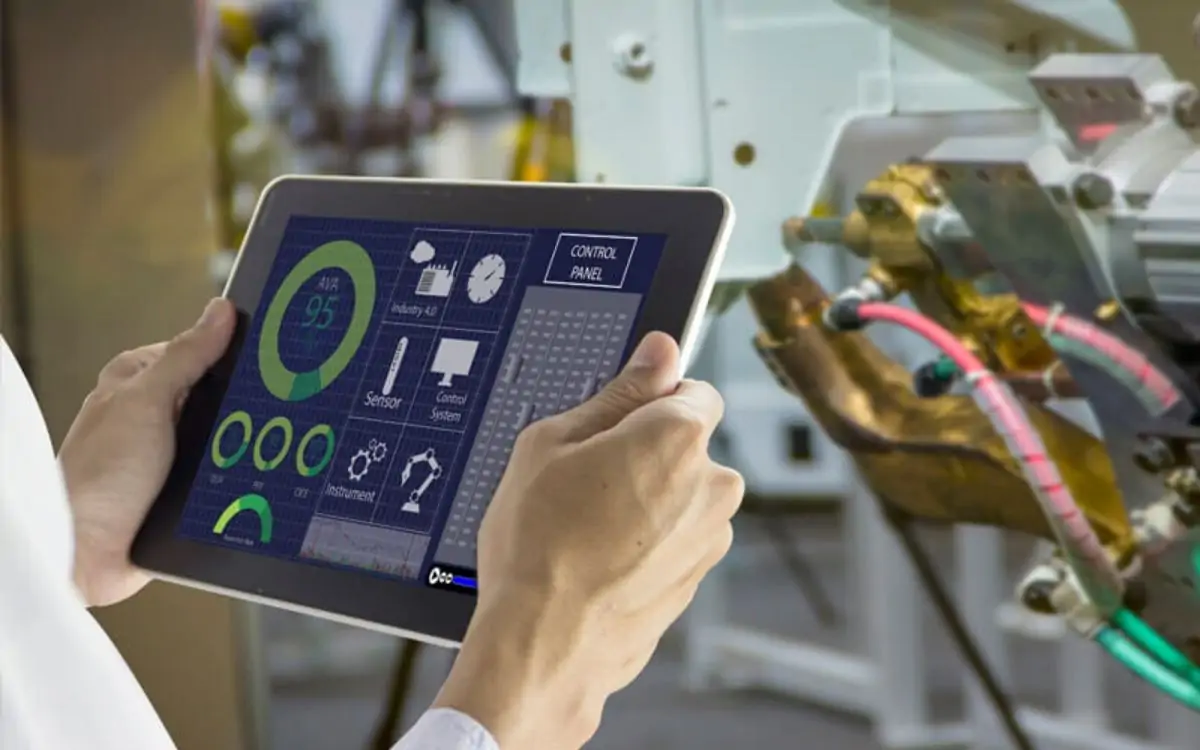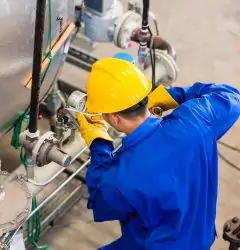04 Dec

Unexpected breakdowns are the bane of any business. Manufacturers especially can suffer significant losses when equipment and machinery fail. Therefore, preventive maintenance is the best way forward. Not only can it help reduce unplanned breakdowns, but it can also reduce the cost of upkeep and repairs as well as the time and effort wasted. A preventive maintenance program further improves upon this concept by automating the process and combining it with machine learning and computer vision. These advanced technologies significantly reduce the margin for error and help streamline the entire preventive maintenance effort.
Preventive maintenance program definition/meaning
Preventive maintenance is upkeep that is regularly performed on a piece of machinery to reduce the likelihood of critical failure. By definition, the intent behind this type of maintenance is to stop equipment and machinery from breaking down in the first place rather than waiting for it to stop working unexpectedly and then fix it.
A Preventive Maintenance Program is one step further. It is the comprehensive plan of how to approach preventive maintenance and how to execute each element of the repairs process. The Program includes aspects of routine scheduling inspections, what parts should need replacing when depending on the level of damage and also who is responsible for what. Ideally, the entire process runs through Computer Maintenance Management Software (CMMS) which takes care of the finer details prone to human error.
Suitable applications of preventive maintenance include assets that have a critical operational function, preventable failure modes through regular maintenance and a likelihood of failure that increases with time or use. On the other hand, assets that tend to crash randomly and unrelated to upkeep (such as circuit boards) and do not serve a critical function are unsuitable for preventive maintenance.
Types of preventive maintenance programs in 2020
Any form of upkeep that is not a reaction to a breakdown or failure of qualifies as preventive maintenance. Furthermore, there are many different types of preventive maintenance that are all just as effective as the next depending on your company’s requirements.
Usage-based maintenance
Meter readings entered into a CMMS support the decision-making process in this case. The CMMS generates work orders for routine maintenance as soon as the meter reaches pre-determined usage counts.
Predictive maintenance
The CMMS uses usage data to predict when the next breakdown is likely to happen and then schedule repairs for the concerned machinery in advance. By using historical data of usage patterns and the operating environment, the system forecasts potential hazards and a suitable time to correct or repair them.
Prescriptive maintenance
Prescriptive maintenance is similar to predictive maintenance, but instead of only the maintenance manager prescribing PMs, machine learning software assists in determining the best course of action
Time-based preventive maintenance
A time-based preventive maintenance system is relatively simple. The CMMS triggers regular inspections based on estimate life of a piece of equipment. Each scheduled inspection preempts expected breakdowns due to wear and tear over time, regardless of usage. For example, annual servicing of machinery to remove dust and built-up waste matter to avoid clogging and overheating of the mechanism.
The pros and cons of a preventive maintenance program
There are many advantages to a preventive maintenance program, but there may be a few disadvantages. In this section, we discuss three of each to give you a good idea of what you will be getting into.
Benefits of preventive maintenance
Better Planning Means Lower Overtime Costs
The ability to plan is the most significant advantage of any preventive maintenance program. Unexpected shutdowns lead to high overhead costs, lost production, more expensive parts and extra charge for urgent shipping. In some cases, unplanned maintenance can cost anywhere between three to almost nine times more than planned maintenance.
Streamline scheduled maintenance
Routine maintenance can be scheduled on off days or in periods of low demand to minimise any impact on assets and business operations during a maintenance event. Downtime can significantly disrupt revenue streams and supply consistency, thereby causing damage to the company’s reputation.
Greater mobility of response
Most business applications today offer compatibility with a variety of handheld and mobile devices. By using a readily available to tool for data input, the CMMS can significantly streamline workflow and reduce response time to changes in maintenance needs. Often, the difference between a quick recovery and a lag in productivity is the speed with which you can initiate a change in protocol. The utilisation of preventive maintenance software provides managers with all the information they need to make decisions in real-time.
Disadvantages of preventive maintenance
The initial cost of the software
The software may cost a significant amount at the onset since the vendor has to take into account the manufacturing processes, the various kinds of machinery and materials involved as well as the operating environment. Any unique conditions may affect the condition monitoring and maintenance scheduling aspects of the CMMS.
The need for trained personnel
To use preventive maintenance software effectively, training of employees becomes necessary. If you do not train existing personnel, you will need to hire somebody to manage and maintain the software. Any training must be dynamic and cover all areas of maintenance. The concerned staff would have to take out time from when they could otherwise be generating revenue for the business.
Potential room for human error
Especially in the case of predictive maintenance, there is still significant room for error if there is any mismanagement of data when using a CMMS. Since the software relies heavily on historical records and the requirements set by the company, any errors can lead to poor scheduling of routine repairs leading to unplanned breakdowns.
How to do a preventive maintenance schedule and planning
A CMMS, as mentioned before, is an equipment preventive maintenance program system which supports maintenance effort by giving the user a birds-eye-view of all facilities and locations. This ensures that the use of the preventive maintenance program template is adequate. The CMMS also provides many tools including automatic triggers, reminders, information about equipment and auto-assigned tasks which can help streamline the company’s maintenance process.
Here we discuss a five-step plan for developing a complete program for preventive maintenance.
Step 1: Create a Plan
Depending on the company size, maintenance managers, maintenance techs and employees from accounting or finance departments are most likely to be involved with any maintenance project. For successful implementation, complete ownership from all staff involved is a must. Therefore, make goals for the project that are realistic and achievable. If the company objectives are too complicated or far-fetched, it will be difficult getting employees on board.
Step 2: Inventory Facility Equipment
Next, go through the entire facility, take inventory of related equipment and identify the most critical areas for focus. Although this is a time-consuming task, it is vital. If you happen to overlook a small but significant process, all future preventive maintenance efforts will be flawed.
Keep in mind to take down as much detail as possible of the relevant machinery including the make and model, serial numbers, specifications and any internal asset identification numbers. Also not the current physical condition and fixed location which can help prioritise its importance as part of a preventive maintenance system.
Step 3: Create preventive maintenance procedures
Next, identify tasks required for maintaining the equipment and the frequency of occurrence for each job. The intervals can be weekly, monthly, quarterly, semi-annual or annual. Also, determine the ideal time during a workday or season, which will minimise the impact on productivity. All in all, a preventive maintenance plan should include the following:
- A list of required parts;
- Standard Operating Procedures (SOPs);
- Safety and lockout procedures;
- Estimated completion time for each preventive maintenance task.
Step 4: Create a preventive maintenance schedule
Make a list of high priority items in each preventive maintenance plan. These items will form the starting point for all upkeep efforts. Given the time needed to develop preventive maintenance systems, schedule higher priority maintenance before overloading staff with lower-ranking tasks. Secondly, schedule tasks that intervals ranging between annual and quarterly first since these will probably require the most time and effort. Once these are complete, shift focus towards low priority tasks to fill the gaps between the long term and high priority preventive maintenance tasks. Make sure the schedules are realistic by balancing priority preventative maintenance, the time and effort required and the possibility of other external emergencies that might occur.
Step 5: Train your maintenance team
Even though the development of a preventive maintenance program takes considerable time, proper implementation and adoption of the CMMS are crucial. Companies should prioritise training its maintenance staff as they are the core users of the system. Remember not to hold back on training since having the team own the software and help in its adoption will ensure the highest ROI.
EcoDocs preventive maintenance program service
EcoDocs is a CMMS developed by Folio3 and is the market leader in equipment preventive maintenance program. Through an amalgamation of Artifical Intelligence (AI), Machine Learning (ML) and Computer Vision (CV), EcoDocs automates the preventive maintenance process more effectively than the completion.
You can easily avoid repairs and incessant asset failures with EcoDocs. It offers a comprehensive preventive maintenance program template to help you understand how best to develop your preventive maintenance program. You can create preventive maintenance schedules based on several interval choices with a wide range of options for scheduling recurring and non-recurring tasks. You can also create both aesthetically pleasing and functional preventive maintenance checklists and allocate them to any job. With EcoDocs advanced mobile device functionality, you can enable workers to carry their lists on their smartphone on-the-go.
Similarly, workers can capture equipment data for rule-based preventive maintenance and schedule recurring maintenance tasks with ease based on the task completion date.
Some of the core features offered by Folio3’s EcoDocs include:
- Work order software
- Dynamic forms and checklists
- Preventive maintenance software
- Asset management
- Inventory management
- Mobile CMMS
- Multi-site compatibility
- Advanced reports
Conclusion
Suffice to say; a preventive maintenance program is an answer to many of the problems faced by business today. With rising costs of production, companies cannot afford unplanned breakdowns more than ever. Not only do these bring with them unwanted expenses, but it also becomes difficult for management to forecast supply and exploit opportunities to procure cheaper parts.
CMMS companies such as EcoDocs offer automated solutions that enable the business and the people in it to plan, execute and monitor preventive maintenance effectively.
Preventive Maintenance Program FAQs
Which action supports an effective preventive maintenance program?
The realistic and timely planning of all requirements and tasks is the best way to achieve an effective preventive maintenance program.
What is the purpose of a preventive maintenance program?
The purpose of preventive maintenance programs is to enable the company to plan routine maintenance through automation before machinery and equipment can breakdown
Why is preventive maintenance better than reactive maintenance?
Reactive maintenance usually costs more in terms of lost productivity, time and reputation. Shutdowns can be expensive affairs. Preventive maintenance, on the other hand, stops critical functions from deteriorating, thereby preserving the integrity of business operations.
EcoDocs is a cloud-based CMMS software that organizes, tracks, and schedules your quality, compliance, and maintenance management tasks, making your workers more agile and productive.




Ecodocs